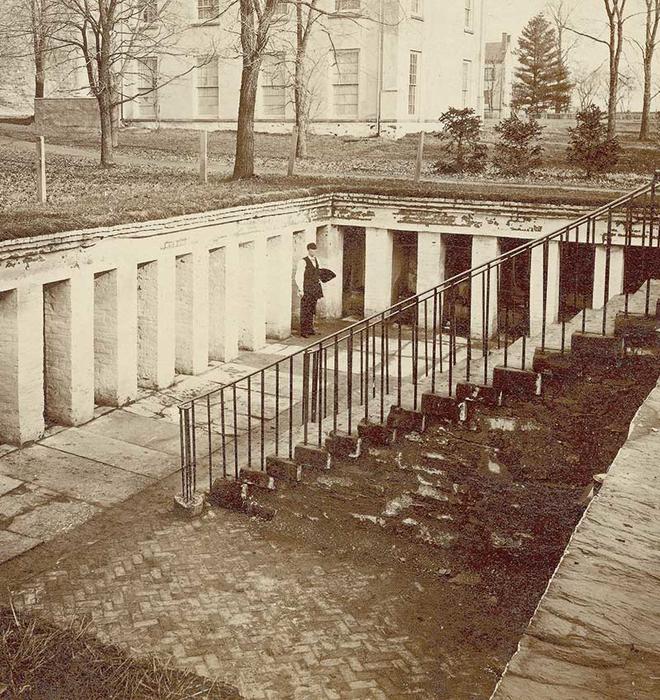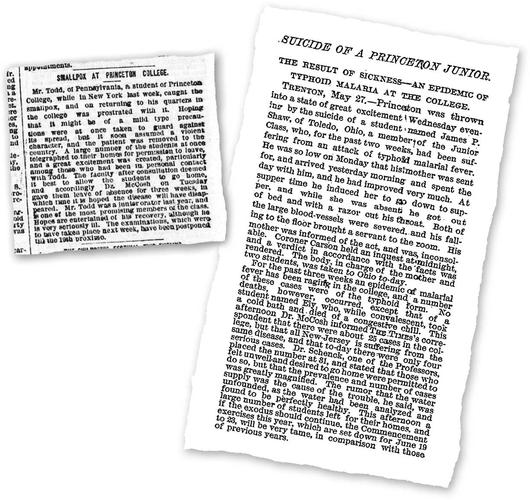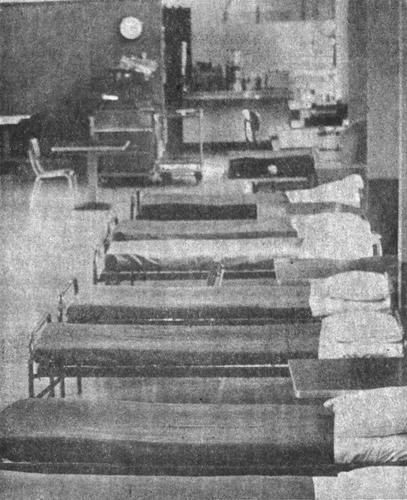
‘A Prolific Harvest of Death’
COVID-19 is only the latest epidemic to strike Princeton — here’s how the University handled others
Even the oldest alums agreed that they had never seen a Commencement week like it. Princeton in the third week of June 1880 was half empty, the undergraduates sent home several weeks early to escape an outbreak of typhoid fever. “The breaking up of the session has afforded classmates, acquaintances, and the College generally, little or no opportunity to notice the absence of those who have been removed from us by death during the few weeks past,” The Princetonian reported later that summer, a sentiment the Class of 2020 might understand. In all, 40 students were affected; and 10 — among a total enrollment of 473 — died. To put those numbers in perspective, it would be the equivalent today of 729 students getting sick and 182 dying, all in the space of five awful weeks.
Class Day was canceled and the graduation ceremony itself trimmed to just the orations and the conferring of degrees. Those graduates who were brave enough to return (before the formal creation of Reunions) were intercepted at the train station by members of the faculty and told that the dormitories and the University Hotel were too dangerous to be occupied, so they must find lodgings in town.
On Commencement morning, Princeton president James McCosh climbed the pulpit of the Presbyterian Church on Nassau Street to deliver his annual state of the College address, speaking first to the subject on everyone’s mind. “Princeton, it is well known, is a healthy locality,” he began. “Never visited by any epidemic, we had become too confident and did not take sufficient precautions to remove the sources and causes of fever.” Two students, he noted, had died in their dorm rooms, “happily with their parents beside them.” McCosh was too circumspect to mention that one student, a junior named James Shaw, had slashed his throat with a razor in a typhoid-induced delirium while his mother, who had come to care for him, was out of the room. The other unfortunate young men died at home.
Nevertheless, the president promised, “By the opening of next term on Sept. 8, our college will be in a thoroughly satisfactory sanitary condition.”
In terms of its scope and duration, COVID-19 is the most significant epidemic ever to affect Princeton. Never before in peacetime have students been sent home for nearly half a semester, campus buildings locked, and Reunions canceled.
But the coronavirus is hardly the only outbreak to strike in Princeton’s long history. The largest, and perhaps the most notable, was the Spanish influenza of 1918. Fifty million people died worldwide, but there were no deaths on campus, thanks largely to an aggressive program of what would today be called social distancing. The 1918 flu outbreak was unique in that it struck during World War I, when Princeton was more of a military camp than a college. There were fewer than 100 regular students on campus, and most decisions regarding the outbreak were made by military authorities rather than the University administration. (See “Why Princeton Was Spared,” PAW Dec. 17, 2008.)
Before the development of vaccines or a full understanding of germ theory, however, Princeton was visited by many infectious diseases now thankfully forgotten: scarlet fever, measles, mumps, whooping cough, diphtheria, and others. (The staff at Mudd Library has posted extensively about Princeton epidemics, including links to archival documents and news accounts.) Almost always, the sick were cared for, to the extent medical science knew how, and life struggled on. On a few occasions, though, disease brought the routine of academic life to a halt.
Like his predecessors, McCosh believed that Princeton’s elevation and location, far from the crowded cities, protected it from epidemics. For the most part, they were right.
During an outbreak of dysentery in 1813, the trustees’ minutes state, President Ashbel Green 1783 “reported that in his thirty years’ intimate acquaintance with the institution he had never known so much illness.” Fortunately, Professor Elijah Slack prepared a “chemical fumigation” from a formula he found in a foreign scientific magazine, which “had a most wonderful, speedy and happy effect in purifying the atmosphere.”
A cholera epidemic, originating among laborers digging the Delaware & Raritan Canal, caused a panic in August 1832 while school was in session. Parents ordered their sons to leave town, forcing President James Carnahan 1800 to close the college. “[B]y reason of the alarm occasioned by the threatened approach of Pestilence,” the trustees’ minutes state, “it became impossible to keep any of the College Classes together ... .” Nevertheless, Commencement, which was held later in those days, took place on schedule in late September, though the resumption of classes was nearly a month late.
Similarly, in March 1871, a senior named Edward Todd came down with smallpox — contracted in New York, not locally, College officials were quick to emphasize, but families panicked anyway. “A large number of the students at once telegraphed their homes for permission to leave,” a reporter wrote in the New York Herald, “and a great excitement was created, particularly among those who had been in personal contact with Todd.” President McCosh closed the College for three weeks. Smallpox incited another panic in 1899 when a student, R.S. Steen 1901, fell ill. Students jammed every available train out of town — but no further cases were reported, Steen recovered, and classes continued.
Those who fell ill during the McCosh administration (1868–88) were often cared for by his wife, Isabella. Princeton did not have a hospital at the time, so each morning Mrs. McCosh would pick up a list of sick students and visit each one herself, bearing food or medicine, as needed. She also pushed her husband to raise funds for Princeton’s first infirmary, which opened in 1892 and was named (over her objections) in her honor. (See “Caring and Kindness, Along with Spunk,” PAW Oct. 24, 2018.)
Not even the ministrations of Isabella McCosh, however, could alleviate the scourge of typhoid fever in the spring of 1880.
Throughout the 19th century, the campus drinking water came from wells and was generally potable, if not appetizing. “A mineral spring has been discovered,” wrote theologian James W. Alexander 1820 in 1828, “that is, as in similar cases, a hole in the mud has been discovered which possesses rather more nastiness than the common water, which tastes like a gunwashing, more like a blacksmith’s tub ... .” Well water was then mechanically pumped to the few campus buildings through iron pipes.
Dormitories did not have indoor plumbing until Witherspoon Hall opened in 1877, and none of them had bathrooms until early in the 20th century. “Water closets,” as they were called, were little better than holes dug in the basement floor; the nicest ones, in Nassau Hall, had glass partitions that afforded a small measure of privacy and were known as the “crystal palace.” Fastidious students poured their chamber pots into the common sinks each morning. Many just dumped them out the window.
Everyone also used the privies, which were located just below Whig and Clio Halls and were referred to as “Cloaca Maxima” (“the Big Drain”) or “The Temples of Cloacina.” The classical jokes notwithstanding (Cloacina was the Roman sewer goddess), these outhouses were horrid affairs. “The walks were muddy and not lighted at night,” Edward Shippen 1845 recounted. “The erections themselves were not better than one would see at a country fair — of rough pine boards and with no sinks. They were detrimental in every way, as persons often used utensils and dumped them in improper places. Many who were more conscientious avoided going there at night, (or in bad weather) to the injury of their health.”
Students routinely burned the outhouses or, on at least one occasion, blew them up with gunpowder, a sport the college authorities tried to stop in 1861 by building an in-ground, multi-seat latrine, which made the facilities more permanent but no more appealing. From there, the college’s waste flowed through iron pipes into a huge earthen cesspool — 60 feet long, 10 feet wide, and 14 feet deep — located roughly where Dillon Gym stands today. Because the cesspool was never cleaned, much of the waste (“a black, tarry, offensive sewage,” state investigators reported) backed up into the pipes or leached into the ground, eventually fouling the wells that provided the campus drinking water.
“Despite the fact that, for weeks, disinfectants had everywhere been abundantly used,” another report on the epidemic stated, “the odours from some of the fixtures was noisome in the extreme.”
Seven students fell ill within a few weeks of each other beginning in late April 1880. Investigators discovered that the well they all drank from had been contaminated by the University’s backed-up cesspool. (The well also contained a dead cat.) Once everyone realized that the sewage system was responsible, McCosh and the trustees halted classes. “We believe thus only was it saved a far more wide-spread and fatal epidemic,” the minutes stated. “At the very day of adjournment we found the excreta of typhoid fever patients being emptied in a common water closet, and believe that the seed had been sown for a prolific harvest of death.”
President McCosh was philosophical. “We should all bow under the event as a dispensation of Providence meant to humble and chastise us,” he told the trustees, but outside observers, including the New York newspapers, were more critical. By August 1880, the University had begun to build a new, cement-lined cesspool, disinfect the sewer pipes, and dig new wells. This remained the Princeton sewer system until a treatment plant opened in 1914, which released treated wastewater into Lake Carnegie.
Opening exercises were postponed again in 1916 during a short but deadly outbreak of polio. Although polio had existed for millennia, the first case did not appear in the United States until 1894 and the first large-scale outbreak until 1916. It was concentrated in New York City, which reported more than 9,000 cases and 2,343 deaths, and by August had spread to New Jersey.
This was not the first time polio had appeared on campus. Two students died within a month of each other in 1910, and many students evacuated Princeton in fear. With this and the ongoing epidemic no doubt in mind, President John Grier Hibben 1882 announced in mid-August that opening exercises would be postponed for three weeks, until mid-October, in hopes that cooler weather would slow the spread of the virus. Nevertheless, many students, bearing University-mandated certificates of good health from their doctors, returned early to watch the football game against the University of North Carolina.
A week later, on Oct. 14, Hibben called a special meeting of the senior council (a predecessor of today’s Undergraduate Student Government), which adopted what was essentially a self-quarantine: Students would avoid movie theaters, stay off Witherspoon Street “and other congested districts,” dine only in the newly opened Commons or at the eating clubs, and remain in town. Although it is impossible to say whether Hibben’s actions spared the campus from greater harm, freshman Eric Brünnow, son of a Princeton professor, died of polio the following day, just hours after going to the infirmary complaining of a stiff neck. No further cases were reported, though, and the restrictions were lifted Nov. 9.
Students sometimes reacted to a potential outbreak not with terror, but with hope — that classes might be canceled because of it. “The undergraduates appear to be more susceptible to rumor than to typhoid fever,” The Daily Princetonian editorialized amid a rumored outbreak of that disease in 1914. In 1940, amid reports that the University might close early because of chicken pox, students hung a note on the office door of President Harold Dodds *1914:
Chicken pox’ll get us;
It’s a dangerous disease.
There should be a two weeks’ recess;
Give it to us, please.”
The administration did not give them a recess.
The most virulent outbreak since World War II was the 1957 influenza epidemic, which affected one quarter of the undergraduates and 10 percent of the graduate students. If the 1918 flu epidemic provides a case study in the benefits of quarantining in place, this might serve as a counterexample.
Known (in those pre-PC days) as the Asiatic flu, the 1957 outbreak originated in Hong Kong in April and reached the United States by summer, spreading up the East Coast and hitting college campuses especially hard. The first reported case at Princeton occurred Friday, Oct. 4, and by the following Monday, as students returned from the Columbia football game in New York, 79 students jammed the infirmary, with another 20 confined to their rooms.
By Oct. 15, the number spiked to 150. Extra beds were placed in the McCosh hallways, and nurses worked double shifts as incoming students waited an hour or more for attention. Dean of the College Jeremiah Finch was forced to cancel all student activities for the upcoming Colgate football weekend, including the sophomore dance, a folk sing at Theatre Intime, and a concert in Richardson Auditorium by The Talbot Brothers, a calypso group.
“One particularly miserable senior,” PAW reported, “just after having had a weekend flushed by the flu — was reported to have lamented, ‘I mean, it’s tragic — this Asian flu is ruining my senior year! Now I’ve got nothing at all to do but work on my thesis.” Remarkably, the football game itself was not canceled, and Palmer Stadium was packed as usual on Saturday afternoon.
By Oct. 16, though, the infirmary was strained past the breaking point and Dr. Wilbur York, chairman of what would now be called the University Health Services, was forced to commandeer Chancellor Green Hall, including the cafeteria, the library, and the balcony, to handle the overflow. In the space of an hour, 100 beds were moved in and phone lines installed. As for supplies, the University “had already laid in a large stock of juices and other liquids,” the Prince reported. More than 20 nurses from the local Red Cross provided care, while students who had already recovered from the flu, and thus were immune, were recruited as orderlies.
The numbers seemed to stabilize, prompting the administration to permit social events for the Cornell game the following weekend and allow students to travel to Brown the weekend after that. A pattern thus repeated itself: The number of cases would drop during the week, only to surge again after a weekend of activities as authorities either couldn’t or wouldn’t put two and two together. At least two cases developed into pneumonia. The Chancellor Green cafeteria, however, reopened on Oct. 28 in time to host a University League tea that had previously been scheduled there, “and the entire building was given a good airing.”
Seven students fell ill within a few weeks of each other. Investigators discovered that the well they all drank from had been contaminated by the University’s backed-up cesspool.
Another surge forced patients back into the cafeteria just before Halloween. Even those who weren’t hospitalized sounded sick, PAW reported, their coughs echoing around campus. “The cough was almost always a good, lusty, chesty type which sort of set one apart as the bearer of a badge of courage and defiance — no infirmary was going to get his hands on him. No sir!”
A vaccine, which had been developed over the summer, reached campus in late October and 1,176 students turned out to get it, at the cost of $1 apiece. By the second week of November, the flu had largely run its course, PAW noted, leaving “several hundred wan undergraduates to dig themselves out from under weeks of neglected course assignments.” It was a rough year at the infirmary, however, as 223 students developed rubella during the second semester.
Amid the polio outbreak in 1916, Joseph Raycroft, chair of Princeton’s Department of Hygiene and Physical Culture, tried to reassure anxious students. “If you ‘catch’ cold don’t try to ‘work it off,’” he counseled. “Go to the infirmary for a day or so until you have recovered. Take it easy, do your work, and don’t worry. You are as safe in Princeton as anywhere.”
Vaccinations and sanitation have largely removed the threat of infectious disease from modern life. Even so, there have been occasional outbreaks on campus in recent decades, most recently the H1N1 (swine) flu in 2009. Today, however, we are a more litigious society, more risk-aware and risk-averse, and the sort of fatalism that Raycroft expressed no longer drives us.
Neither, though, does Raycroft’s confidence that one is as safe in Princeton as anywhere. With improved communication and transportation, the University has come to recognize that what happens in far corners of the globe affects the health of Princeton — and vice versa. In 2013, for example, it launched a campuswide vaccination effort after seven undergraduates and a visiting high school student contracted meningitis B. More than 5,600 people eventually were inoculated.
It is noteworthy that the University closed the campus on March 17 after one student and five staff members had tested positive for COVID-19. In his message to the community, President Christopher Eisgruber ’83 did not muse that the disease was an instrument of divine chastisement, as James McCosh might have done. Instead he stated, “People throughout the world are acting to slow the spread of a dangerous virus that threatens to strain the capacity of our hospitals and caregivers. Princetonians are stepping up and doing their part.” It was a charge to a university that now sees itself as serving not only the nation, but humanity.
Mark F. Bernstein ’83 is PAW’s senior writer.








No responses yet